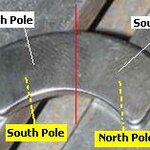Physics
New fundamental particles aren’t found only at Fermilab and at other particle accelerators. They also can be found hiding in plain pieces of ceramic, scientists at the University of Illinois report.
The newly formulated particle is a boson and has a charge of 2e, but does not consist of two electrons, the scientists say. The particle arises from the strong, repulsive interactions between electrons, and provides another piece of the high-temperature superconductivity puzzle.
Twenty-one years ago, superconductivity at high temperatures was discovered in copper-oxide ceramics (cuprates).…

Each time you press "save" on your computer you force atoms on magnets to align their polarity with the intruding magnetic field. Helping physicists understand why it happens and why it isn't a physics-induced train wreck more often is the goal of Joshua Deutsch and Andreas Berger and they say their research could advanced materials research.
Correcting even a single typo in an e-mail means changing dozens of bits of information. For each bit, a magnetic head grazes a tiny patch of your disk drive, forcing its polarity, or "spin," to align up or down--the magnetic equivalent of a one or a…

It may seem odd to think about using metallic structures for transmitting light because light quickly attenuates on passing through a metal, but light waves travelling only a few centimeters don't lose their energy and that discover could change the face of nanotechnology.
The discovery, known as acoustic plasmon, are surface plasmons formed by the group excitation of electrons but it is produced by the interaction between light and metal surfaces.
The advantage of acoustic plasmons over the long-known surface plasmons is that they are created with a different amount of energy. While common…

A research team headed by Yadong Yin at the University of California, Riverside has created a liquid that changes its color “on demand” and can take on any color of the rainbow.
Nanoscopic particles made of tiny magnetic crystals coated with a plastic shell self-assemble in solution to form photonic crystals—semiconductors for light. When a magnetic field is applied, the optical properties of the crystals change, allowing their color to be very precisely adjusted through variation of the strength of the field.
The crystals involved are not “conventional” lattices of ions or molecules like…

Very precise time keeps the Internet and e-mail functioning, ensures television broadcasts arrive at our TVs and is integral to a network of global navigation satellites (such as the Global Positioning System) used for precision mapping and surveying, environmental monitoring and personal location-based services. But time can only be useful if it is the same for everyone. And that requires a single source against which we can all check our clocks.
The caesium fountain that NPL operates is one of only a handful of highly precise measurement devices around the world that inform the global…

CERN Director General Robert Aymar announced that the Large Hadron Collider (LHC) will start up in May 2008 despite the fact that a low-energy run originally scheduled for this year has been dropped due to delays, coupled with the failure in March of a pressure test in one of the machine’s components.
In that instance, a magnet assembly known as the inner triplet, provided to CERN as part of the contribution of the US to the LHC project, failed a pressure test. A repair has been identified and is currently being implemented.
The LHC is a scientific instrument of unprecedented complexity,…

A new type of stainless steel alloy developed at Oak Ridge National Laboratory could allow for significantly increased operating temperatures and corresponding increases in efficiency in future energy production systems.
The new alloys offer superior oxidation resistance compared to conventional stainless steels, without significant increased cost or decreased creep resistance (sagging at high temperature). What sets this proprietary material apart from other stainless steels is its ability to form protective aluminum oxide scales instead of chromium oxide scales.
The combination of creep…

At some level, all types of matter that we usually deal with have at least one thing in common - they're made of particles. The solids, liquids, gases and plasmas that surround us are built of atoms, which are made of electrons, protons and neutrons. Protons and neutrons in turn are made of quarks.
According to Harvard University's Howard Georgi, however, there's at least the theoretical possibility that some matter in the universe is not made of particles at all. Georgi has dubbed the mind-bending matter "unparticle stuff," and hopes that we may see signs of it at the Large Hadron Collider…

Samuel Isaac Weissman, a professor and chemist who helped develop the first atomic bomb as part of the Manhattan Project, has died, his wife said Friday. He was 94.
Weissman died Tuesday in St. Louis. His wife, Jane Loevinger, said a cause of death was not known.
Weissman's work with lasers and resonant energy transfer methods at the University of California at Berkeley was cut short when he became one of the first scientists to arrive in Los Alamos, N.M., to work on the Manhattan Project during World War II.
"He spoke of the Los Alamos work with mixed feelings," said his son, Michael…
Physicists of the DZero experiment at the Department of Energy's Fermi National Accelerator Laboratory have discovered a new heavy particle, the Îb(pronounced "zigh sub b") baryon, with a mass of 5.774±0.019 GeV/c2, approximately six times the proton mass.
The newly discovered electrically charged Îb baryon, also known as the "cascade b," is made of a down, a strange and a bottom quark. It is the first observed baryon formed of quarks from all three families of matter. Its discovery and the measurement of its mass provide new understanding of how the strong nuclear force acts upon the quarks…